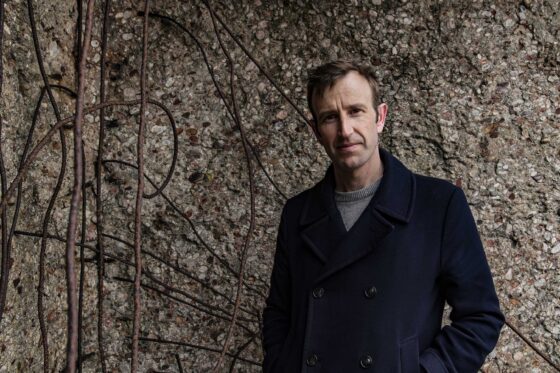Every once in a while, when I’m reading something, sorting through the words in a half-daze, my brain will just click. I’ll get it. I’ll take on an understanding of the text that allows me to better understand the author’s intentions, or how all the pieces work to serve the whole. Of course, these “clicking” moments, and their subsequent understandings, vary from text to text, book to book. Sometimes they won’t occur until I’m reading a book for a second or third time. Other times it never happens. But by far the most rare occurrences are when my click occurs effortlessly and early on in my reading. And as rare as that might be, it’s exactly what happened as I read the first poem of David Mutschlecner’s new collection, Enigma and Light.
The revelatory poem, simply titled “Gertrude Stein / Agnes Martin,” begins with a wonderfully succinct description of Martin’s abstract painting “Milk River.” As the poem unfolds over the next few pages, an astounding level of depth is gradually revealed. Nothing feels forced. Each line is minimalist, interspersed with quotes taken from Stein’s The Making of Americans. We read that Martin makes grids to “graph/nothing—,” that “Along the stream of lights are nodal points,/each a ‘radiant gist,’/a ‘patterened event.'” And then, the six lines that gave me my click:
Martin’s marks are Stein’s
word stipplings,
both inter-patterning one anotheras they could not
without the clear dileneation—
each word girded by the grid.
Like following a stream of lights to a nodal point, I’d arrived at an understanding: this book was something different.
In an author’s statement included with my copy of Mutschlecner’s book, he writes that “seeking the inherent similarity in dissimilars is…the highest goal of poetry.” The question then becomes, what can be revealed in the overlap between works across mediums? It’s a fascinating jumping-off point, the chemical reaction of creative and interpretive overlap. Or how shadow play in a dark room can reveal previously unseen horrors alongside purely incandescent haloes, solely depending on the angle of light. Enigma and Light is made up of pairings, mostly between visual artists and philosophers, thinkers and poets, each seeking that inherent similarity in dissimilars.
Martin Heidegger and Ezra Pound, Thomas Aquinas and Emily Dickinson, Robert Duncan and Dante Alighieri—these are only a few of the pairings Mutschlecner explores in his poems, often arriving at wildly varied forms. For instance, the pairing between German theologian Karl Rahner and the Dusky Seaside Sparrow (taxidermied in this case) results in a uniformly formatted and lyrical poem. Whereas the pairing between Thomas Aquinas and Emily Dickinson has much more esoteric results. Or how both the form and language found in the pairing between abstract expressionist Joan Mitchell and Charles Olson feels wild and playful. There’s a lifetime’s worth of learning on display in this book, the inner-workings of a poet’s education and discipline exposed and decoded. Reading through this book is itself an act of exploration. After all, it is within these new spaces, opened up through intertextuality, that the author is able to explore his self.
Mutschlecner has a real gift for combining imagery, language, and thematics inherent in his subjects. Just take a look at this excerpt from “Georges Rouault / Robert Motherwell.”
The face, the refrain
of the face. Francis Bacon
gave usan igneous
or metamorphic
metaphor:the eyes
boil up, the mouth
smearsunder heat and pressure.
In the geologic
history of painting.
The poem takes on a new significance when you take into consideration the fact that Rouault burned 300 of his paintings at the end of his life. And yet even without knowledge of the artist’s self-destruction, Mutschlecner’s language, his tightly drawn rhythm and sonic repetition made this particularly effective for me. I felt compelled to learn more, to further explore. Whatever the highest goal of poetry might be, the idea of inspiring further learning in the reader is certainly a high-water mark. Poetry is too often private in its profundity, a whisper to oneself, or a scream in an echo chamber. And with that in mind, what Mutschlecner has accomplished here is all the more impressive.
At the end of the book is the two-part “Enigma and Light in Every Relation”—the best approximation of what Mutschlecner set out to accomplish. Using quotes and references from the Bible, Mutschlecner seemingly discovers the roots of his creative evolution. “Light streams across the bowl of the valley/into the high horizon’s peak./I found myself inside a prayer.” It’s fitting that this final poem should be a pairing of the author himself with the very thoughts that fuel meaning in his life, with the very beliefs that demonstrate the beauty so readily apparent in all things.
It becomes that much more powerful, to come to understand that what we see so often precludes some other vision. This is the true nature of peering into the unknown, those dark spaces of self-discovery. Or, as Mutschlecner writes toward the end of Enigma and Light, “The Priest focuses on the crucifix at the far end of the church/that no one else can see;/everyone else looks at the one above and behind the altar, a crucifix/the priest, as he consecrates, can’t see.”




